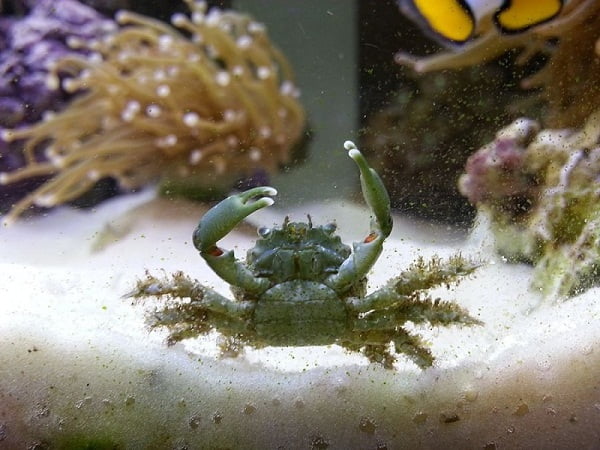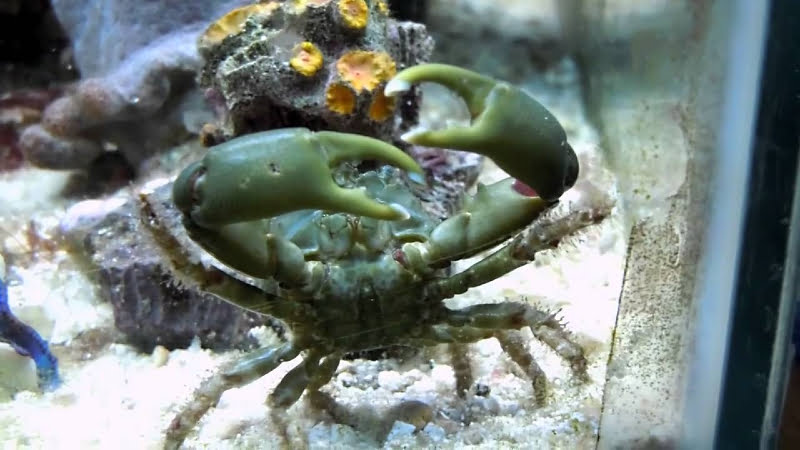Keeping emerald crabs in your marine tank can be a lot of fun and beneficial for your aquarium. They are a great creature to consider getting if you are looking for a creature with interesting colors, a lively personality, and a habit of keeping a clean tank.
Wondering how big do emerald crabs get and how to take care of them to help them grow healthy and reach their optimal size? In this article, we will show you.
See also:
- Do Emerald Crabs Eat Coral?: A New Topic Of Concern.
- How Do Emerald Crab Molt? Top 3 Impressed Facts.
- What Is Emerald Crab Lifespan? How To Take Care Properly?
How Big Do Emerald Crabs Get?
When fully mature, emerald crabs measure around two inches in size. It is, however, a species that comes in a variety of sizes.
You can find smaller specimens that only reach 1.5 inches, as well as larger ones that reach 2.5 inches. However, their body size also depends on many factors such as genetics, living environment, care or nutrition you give them.
Emerald Crab Care
As mentioned above, care affects the health of emerald crabs in general and their size in particular. Here are some notes that you need to be aware of.
This crab is hardy and is well adapted to life in a glass tank. So, caring for emerald crabs is not a difficult task. However, you cannot let them take care of everything. You should also provide a healthy environment for them to thrive. You may find the following guidelines helpful:
Tank Size
For each Emerald Grab I recommend a minimum tank size of 20 – 30 gallons.

Many people keep Emerald crab in smaill tanks as 10 gallons. They can fully adapt and flourish in small tanks. But I don’t recommend doing so. They need a minimal amount of space to scavenge. Also, keeping crabs in small tanks makes them territorial in cramped quarters.
Water Parameters
Emerald crabs can easily be housed in most types of reef and marine tank setups.They do not require too much in the tank but there are parameters that are most suitable for them.
To achieve the best quality of water, keep the following parameters as close as possible.
- Water temperature: 72°F to 82°F (above 75 degrees is best)
- pH levels: 8.0 to 8.4
- Water hardness: 8 to 12 dKH
- Specific Gravity: 1.020 to 1.025 (around 1.023 is ideal)
Food & Diet
There is no difficulty in feeding emerald crabs. Their appetite is healthy and they will eat just about any kind of food you provide them to eat without a second thought!
Emerald crabs are known to eat algae and leftovers. They will help you in getting rid of persistent algae like bubble algae and hair algae. They also look out for detritus and edible creatures to eat
It may be necessary to add supplemental food to your aquarium’s diet if you don’t have an adequate supply of algae. It is okay to use dried seaweed, commercial pellets, and chopped shrimp.
Feeding your crabs is a very important part of caring for them. Otherwise, they may turn to tank mates to eat.
Some Other Related Questions
How fast do emerald crabs grow?
A 3-4-year-old will gain 0.5-1.75 cm per year and will usually top out at around 2-2.5″.
Are emerald crabs hardy?
The Emerald crab is hardy. The fish are capable of adapting to temperature fluctuations quickly, despite living in saltwater aquariums. Though small in size, they are able to withstand strong ocean.
How much does an emerald crab weigh?
These Green bubble algae eater crabs are small, and they weigh 28.2 oz (0.80 kg) approximately.
Conclusion
To sum up, Emerald crabs can reach an average size of 2.5 inches. Their size also depends on many factors. One of the most important factors is the environment and care.
The above article has provided important information for you to set up the best environment and care for Emerald Crab.

Annette M. Chaney is an experienced marine biologist with over 20 years of experience as an aquarist and fishkeeper. She started her first aquarium at a young age, filling it with frogs and goldfish obtained from the ten-cent pet store.
Annette grew up caring for and breeding African Cichlids, which led to a hobby in high school that doubled as a profitable means. Attending Reed College gave her time to solidify herself as an accomplished aquarium caretaker with an eye for sales. After that, from 2009 – 2013, she studied at Roger Williams University – one of the most prestigious universities for Aquaculture and Aquarium in USA. She is the founder of AquariumCircle since 2010.
